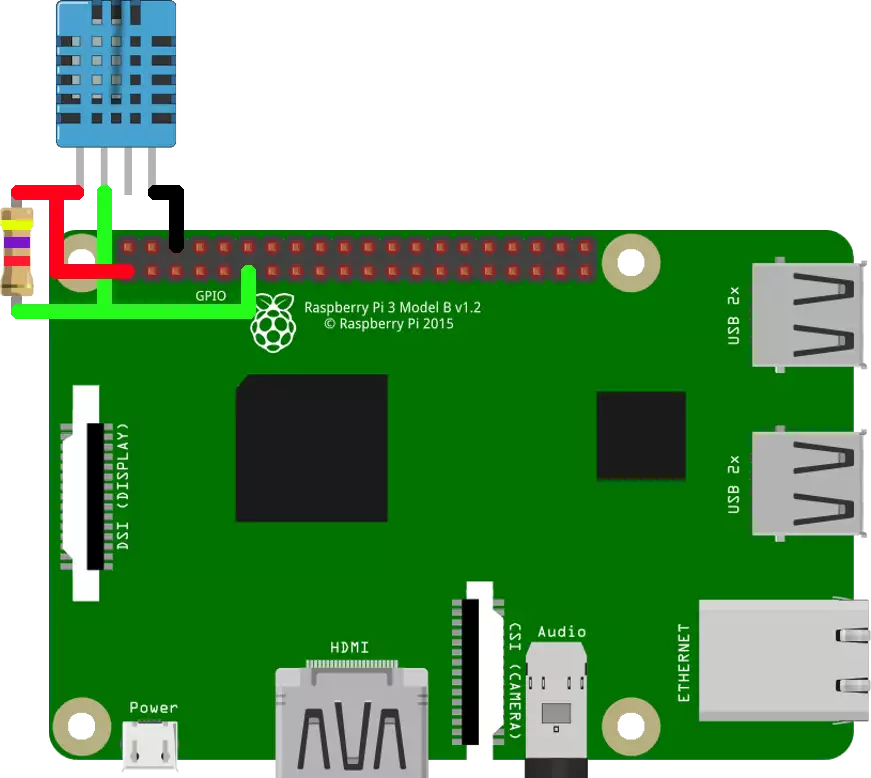Raspberry PI DHT Sensor Control Code
DHT sensors can measure temperature and humidity. You can receive fresh measurements every 2 seconds in the form of digital signals. DHT11 can sense temperature from 0 to 50 °C and humidity from 20 to 80% RH. DHT22 can sense temperature from -40 to 80 °C and humidity from 0 to 100% RH. The DHT Controller Device manages communication between a DHT sensor and the current Ozeki software.

Required hardware
- Raspberry PI
- DHT11 or DHT22 sensor
- Resistor 4.7kΩ
Source code to install on controller
#!/usr/bin/python
# -*- coding: utf-8 -*-
import RPi.GPIO as GPIO
import time
import sys
def bin2dec(string_num):
return str(int(string_num, 2))
data = []
effectiveData = []
bits_min=999;
bits_max=0;
HumidityBit = ""
TemperatureBit = ""
crc = ""
crc_OK = False;
Humidity = 0
Temperature = 0
pin=17
GPIO.setmode(GPIO.BCM)
def pullData():
global data
global effectiveData
global pin
data = []
effectiveData = []
GPIO.setup(pin,GPIO.OUT)
GPIO.output(pin,GPIO.HIGH)
time.sleep(0.025)
GPIO.output(pin,GPIO.LOW)
time.sleep(0.14)
GPIO.setup(pin, GPIO.IN, pull_up_down=GPIO.PUD_UP)
for i in range(0,1000):
data.append(GPIO.input(pin))
def analyzeData():
seek=0;
bits_min=9999;
bits_max=0;
global HumidityBit
global TemperatureBit
global crc
global Humidity
global Temperature
HumidityBit = ""
TemperatureBit = ""
crc = ""
while(seek < len(data) and data[seek] == 0):
seek+=1;
while(seek < len(data) and data[seek] == 1):
seek+=1;
for i in range(0, 40):
buffer = "";
while(seek < len(data) and data[seek] == 0):
seek+=1;
while(seek < len(data) and data[seek] == 1):
seek+=1;
buffer += "1";
if (len(buffer) < bits_min):
bits_min = len(buffer)
if (len(buffer) > bits_max):
bits_max = len(buffer)
effectiveData.append(buffer);
for i in range(0, len(effectiveData)):
if (len(effectiveData[i]) < ((bits_max + bits_min)/2)):
effectiveData[i] = "0";
else:
effectiveData[i] = "1";
for i in range(0, 8):
HumidityBit += str(effectiveData[i]);
for i in range(16, 24):
TemperatureBit += str(effectiveData[i]);
for i in range(32, 40):
crc += str(effectiveData[i]);
Humidity = bin2dec(HumidityBit)
Temperature = bin2dec(TemperatureBit)
def isDataValid():
global Humidity
global Temperature
global crc
if int(Humidity) + int(Temperature) == int(bin2dec(crc)):
return True;
else:
return False;
def printData():
global Humidity
global Temperature
print "{}\t{}\t".format ("Humidity: ", Humidity + "%")
print "{}\t{}\t".format ("Temperature: ", Temperature + "°C")
try:
while True:
pullData();
analyzeData();
if (isDataValid()):
crc_OK=True;
print "\r",
printData();
else:
sys.stderr.write(".")
time.sleep(2);
except KeyboardInterrupt:
GPIO.cleanup()
